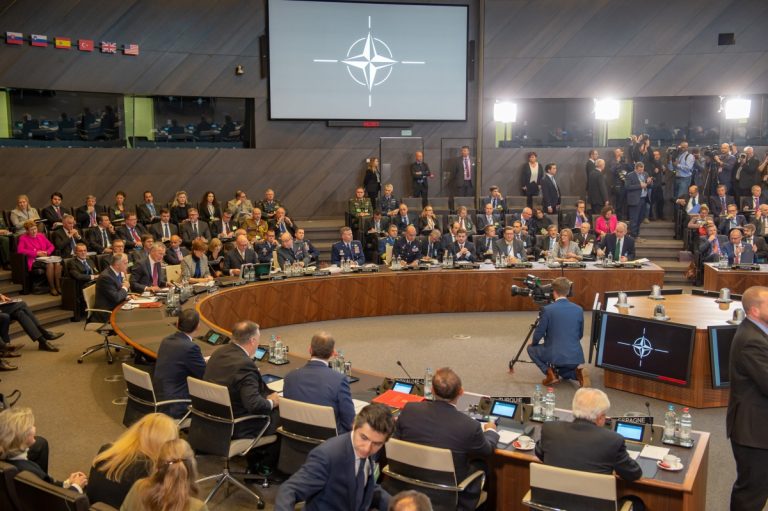On November 20, NATO Foreign Ministers take decisions to adapt NATO and agreed to recognize space as a new operational domain for NATO, alongside air, land, sea and cyber. “This can allow NATO planners to make requests for Allies to provide capabilities and services, such as hours of satellite communications,” said the Secretary General.
NATO Secretary General Jens Stoltenberg said that NATO has no intention to put weapons into space, and the Alliance’s approach to space will remain fully in line with international law.
The decision, set to be taken at a Dec. 3-4 leaders summit in London would formally acknowledge that battles can be waged not only on land, in the air, at sea and on computer networks, but also in space.
Before this, on October 30, Headquarters Department of the U.S. Army approved Field manual (FM) 3-14, Army Space Operations, provides an overview of space operations in the Army which is consistent and compatible with joint doctrine. FM 3-14 links Army space operations doctrine to joint space operations doctrine as expressed in joint publication (JP) 3-14, Space Operations and other joint doctrinal publications.
While NATO countries today own 65% of satellites in space, China envisions massive constellations of commercial satellites that can offer services ranging from high-speed internet for aircraft to tracking missiles and armed forces on the ground. China is developing weapons it could use in orbit and became the first country to land on the far side of the moon last year. The People’s Liberation Army (PLA) has officially designated space as a new domain and established an organization to command space forces.
In June 2016, the Chinese space agency launched its Roaming Dragon satellite into low orbit. Officially, Roaming Dragon is a space-junk collector. Its job, according to Beijing, was to pluck old spacecraft and other debris from Earth’s orbit and safely plunge them back to the planet’s surface. But the Roaming Dragon’s design—specifically, its maneuverability and its nimble, extendable robotic arm—meant it could also function as a weapon, zooming close to and dismantling satellites belonging to rival countries. India in March this year launched an anti-satellite missile test.
Russia, now viewed by many allies as a hostile power, is also a force in space and is one of the few countries able to launch satellites into orbit. In 2016 the chairman of the Joint Chiefs of Staff reported that Russia is modernizing its counter-space capabilities to defeat a wide range of US space-based capabilities, while seeking to secure freedom of action in, through, and from the space domain.
The U.S. Defence Intelligence Agency warned in a report this year that Russia and China were developing jamming and cyber capabilities in space, directed energy
weapons and ground based anti-satellite missiles – though Beijing and Moscow deny any hostile intent.
According to FM3-14, the Space superiority is the degree of control in space of one
force over any others that permits the conduct of its operations at a given time and place without prohibitive interference from terrestrial or space-based threats (JP 3 14).
In unified land operations, space superiority enables freedom of maneuver and accurate fires, when and where needed. Space superiority is a function of the space domain and may be maintained for long periods of time, or obtained for short windows of time for specific operations. Space superiority contributes decisive wins in high-intensity conflicts against any adversary, anytime, and anywhere.
So, the logic of NATO decision is: whoever controls space also controls what happens on land, on the sea and in the air. If you don’t control space, you don’t control the other domains either (Jamie Shea, analyst at Friends of Europe think-tank, Brussels).

Italy, Britain and France are Europe’s main space powers, while Germany is drafting
new laws and seeking private investment to secure a slice of an emerging space market that could be worth $1 trillion a year by the 2040s.
France wants more assurances of how its space assets would be used in the event of a crisis. In other areas of warfare, national assets belonging to NATO allies are put under the command of the supreme allied commander during a conflict.
France has adopted a new “space defense strategy” that will help protect the country’s military satellites from attacks coming from other states, including Russia, Liberation reports. According to the Minister of the Armies, Florence Parly, the space program provides for equipping satellites with cameras, lasers and machine guns, as well as creating a nano-satellite patrolling cloud.
The U.S. military is increasingly dependent on satellites to determine what it does on the ground, guiding munitions with space-based lasers and satellites as well as using such assets to monitor for missile launches and track its forces.
Most sensitive of all would be deciding if an attack on a allied satellite constituted
an assault on the alliance and whether to trigger NATO’s Article 5 collective
defense clause.
NATO’s decision would initially mean increased military planning, a review of
NATO vulnerabilities and scrutiny of how to better protect commercial satellites
used by the military.
The same way in 2018 NATO countries were working to determine when a cyber attack would trigger the collective defence provision in the alliance’s charter. It “recognized the difficulty in indirect or asymmetric activity that Russia is practicing, activities below the level of conflict.
Probably that concerned space operational domain also will be reached a specific
understanding on the issue that would allow “greater agility, greater flexibility in
determining how to respond.






